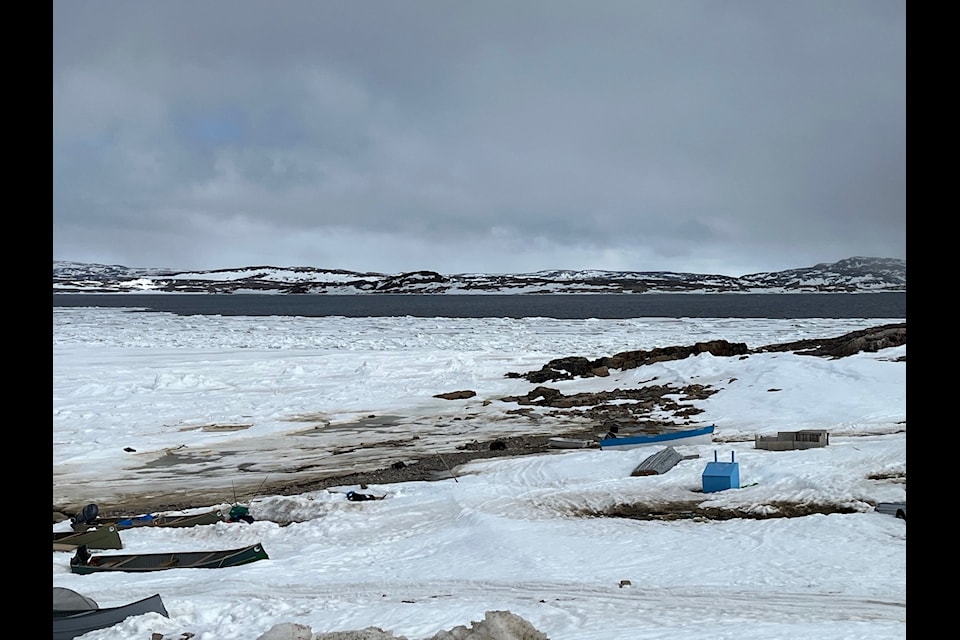Siku is the Inuit term for the coastal sea ice surrounding most of Nunavut in the winter and spring months.
Sinaaq refers to the breakup of this ice and the “floe edge.”
More than a function of temperature and weather, the siku and sinaaq have always been part of the Arctic landscape, and local knowledge of it is integral to the Inuit way of life and the Northern ecosystem — paramount for subsistence hunting, travel between communities and generally sustaining life.
Artists, such as those at the West Baffin Cooperative and Kinngait Studios, have long incorporated depictions of these natural, and naturally shifting, parts of their habitat into their work. Now, however, as climate change accelerates and the effects are felt worldwide, the international scientific community is becoming increasingly interested in how Inuit artists are documenting these changes.
Seizing on this opportunity for increased exposure of a local problem that is actually global in scope, the West Baffin Cooperative, under president Pauloosie Kowmageak, has entered into a five-year collaborative study called 'The Ice Floe Edge' with partners at the National Maritime Museum in London, the University of Aberdeen Museum and Special Collections, and the University of Manitoba. The stated aim for all involved is to use “printmaking and drawing, alongside satellite imagery... [to examine] the stories, science and visual histories of the cryosphere [ice] by working across art history and geography.”
“We’re very pleased that the two universities have partnered with us to get the message out there that things are changing up North,” said Kowmageak in an interview with Nunavut News. “I think [Inuit artists’] perspectives are very different from other people’s... Our studio is facing the floe edge and the sea ice... they can put it on their artwork and show the differences over the years that they see, and that, I think, would be more telling than to talk about it.
“Especially with the pandemic,” adds Kowmageak, “this was a way to get more exposure [to the issue], and see what we can do to make things more viable as long as possible. This [study] is an outcome of that, and it’s important for the community... what effects are clearly felt.
“Many years ago, there used to be a lot of travel to communities on ice... that has been affected quite a bit. Nowadays, there’s less travelling on ice... this year, we had dramatic changes. One day there’s ice, the next day it’s blown away.”
The 'true merging of science and visual arts'
Although it is still “very early stages” in the project, the hope, according to Kowmageak, is that these scientists from different parts of the world will make trips to Kinngait to speak with the artists, Elders, and hunters to further document the changes taking place in Nunavut.
“Unfortunately a lot of the older generation have passed on, but there have been some interviews with them with other agencies, and we will hopefully be able to share their knowledge from the past,” said Kowmageak. “And there are the hunters from the younger generation that see what’s happening out there first-hand, and we’ll try and incorporate their knowledge as well. Some of these hunters are artists too.”
The project is “the true merging of science and the visual arts,” according to William Huffman, general manager for the West Baffin Cooperative. “The idea that we have glaciologists on the one side working on this, and then on the other the partners in Kinngait, who will use their work to provide their visual observations of what is happening with the ice in recent years.
“Suddenly scientists have the rationale to explain what artists are depicting in their work, like sea ice levels and quality of light. These observations have been over an extended period of time, and it's like scientists are catching up now to describe why something is the way it is,” Huffman added.
The project currently has funding for five years, but has the potential to go beyond its current incarnation.
“Part of what we wanted to do with this is give it a horizon so we have a time in between beginning and end in order to add projects and opportunities as they emerge,” Huffman said, also mentioning that he engaged in various meetings with different institutions and museums on his recent trip to the U.K. as more parties heard about the project and indicated interest.
“It’s evident in the art world that this mash up of science and art is something that people are really paying attention to," he said. "I think it has a lot to do with the concern around climate change.”
“Artists are highly attuned to their environment,” adds Hoffman. “Of course this is something they’re going to notice.”
